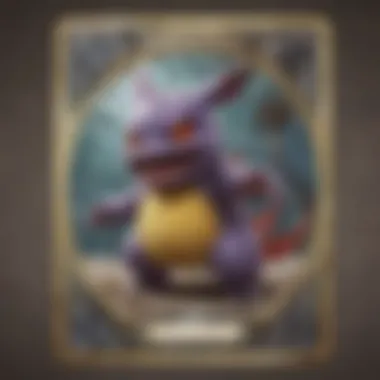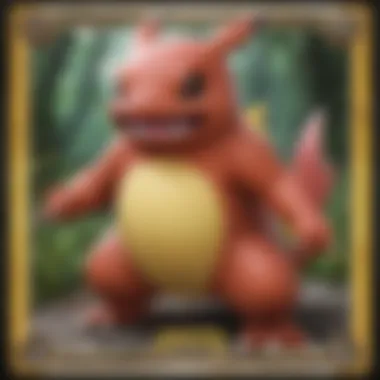Assessing the Value of Your Pokémon Cards


Intro
The world of Pokémon is not just about catching creatures and battling other trainers; it has evolved into a rich culture and a booming market for collectibles, particularly Pokémon cards. With countless trainers and collectors, the question arises: how do you determine the value of your Pokémon cards?
Understanding the worth of these cards involves a meticulous breakdown of factors such as rarity, condition, and current market trends. From novice collectors looking to sell a few cherished cards to seasoned investors amassing extensive collections, this guide will help you effectively assess the value of your Pokémon cards.
Whether you’re dusting off a shoebox from childhood or refreshing your existing collection, proper evaluation methodologies can mean the difference between pocket change and a significant payday. Therefore, we’ll navigate through key concepts that play an essential role in card valuation, using a clear and comprehensive approach to arm you with the tools necessary to succeed in the dynamic Pokémon card market.
Pokemon Card Market Overview
Before delving into the evaluation process, it’s crucial to grasp the landscape of the Pokémon card market itself. Cards can fetch prices ranging from a few cents to several thousand dollars, largely dictated by rarity and demand. The allure of owning a valuable card such as a Holographic Charizard or an Original Pikachu keeps collectors motivated
By getting a handle on how grading works, potential buyers can understand that cards receive scores based on condition - essentially how well it��’s held up over time. Cards graded as PSA 10, for example, are typically the holy grail, while lower grades may represent a fraction of that worth.
It’s also essential to keep an ear to the ground when it comes to market trends. Following news from platforms like reddit.com or Facebook groups dedicated to collectors can provide insights into which cards are climbing in value and which ones may be on the slide.
In summary, understanding the Pokémon card market lays the groundwork for a successful evaluation process, ultimately setting you up for informed selling or trading strategies.
Understanding Pokémon Card Valuation
In the ever-evolving world of Pokémon card collecting, understanding the nuances of card valuation is essential. Whether you are just starting to sift through your childhood collection or you are a seasoned investor looking to expand your portfolio, knowing how to accurately assess the worth of your cards can make a significant difference. The value of Pokémon cards extends beyond mere nostalgia; it can influence market decisions, affect trading strategies, and even determine potential profit when considering sales.
A clear grasp of valuation provides collectors not only with insight into their current holdings but also into the fluctuations that occur due to various factors such as rarity, condition, and market trends. The Pokémon card market, much like the creatures it celebrates, can be unpredictable. Thus, staying informed is key to making the right moves at the right time.
Factors that contribute to card valuation can often feel like a tangled web. Rarity dictates how many copies of a card exist, while demand reflects a collector's desire for specific cards, often influenced by current trends in the gaming or entertainment industry. Each of these elements plays a pivotal role in determining the final market price.
To build a solid foundation in Pokémon card valuation, it is vital to start with the basics. Understanding how precursor elements contribute to overall worth will pave the way for more advanced evaluation techniques later on. Let’s delve deeper into the fundamental aspects of card value, starting with the basic elements that define it.
The Basics of Card Value
At its core, the value of a Pokémon card can be measured based on a few primary factors: rarity, condition, demand, and historical significance. For newcomers, it might feel like navigating a maze, but once you connect the dots, the bigger picture emerges. Here are the key aspects to consider:
- Rarity: Generally, the fewer cards available, the more valuable they become. Special editions and limited releases hold a premium due to their limited quantities.
- Condition: The physical state of the card heavily influences its worth. A card that's pristine can command far more than one that is worn or damaged.
- Demand: Popular characters or cards that play pivotal roles in game mechanics can see surges in interest, directly impacting their value in the market.
By understanding these foundational elements, collectors can begin to formulate a realistic perspective on what their cards might be worth.
The Role of Rarity
Rarity is arguably one of the most significant factors in the valuation of Pokémon cards. Each card belongs to a category of rarity, ranging from common to ultra-rare.
For instance, First Edition cards carry a level of prestige and are highly sought after among collectors. These cards were printed as part of the initial print run—think of them as the "gold standard" of Pokémon cards. In contrast, newer printings of popular cards might not carry the same weight, even if the artwork or mechanics are similar. This difference becomes evident when assessing price tags in marketplaces.
Here are some examples of rarity classifications:
- Common Cards: Usually, in abundant supply, these cards are less valuable, often mere cents on the dollar.
- Uncommon Cards: Slightly harder to find, these can still typically be had for a few bucks.
- Rare Cards: Often appearing with special foil or holographic attributes, these cards naturally attract more excitement.
- Ultra Rare and Secret Rare: Cards in this category can reach staggering prices, depending on their current market demand. Collectors often sandbox their hopes into obtaining these elusive cards.
Recognizing the rarity of each card is crucial. Certain cards can skyrocket in worth based on their scarcity—an aspect that requires keen eyes and, often, timely research to ensure you're holding onto a hidden gem.
Market Demand and Trends
Market demand is like the pulse of Pokémon card collecting. It can fluctuate wildly based on trends in pop culture, nostalgia cycles, or game mechanics updates that invigorate interest in particular cards or sets.
For instance, when a new Pokémon game releases or a character becomes popular in an animated series, the value of cards associated with that character can surge. Collectors may rush to snag that Charizard, driving up prices to absurd levels, sometimes greatly exceeding their initial values.
Some factors influencing market trends include:
- Cultural Events: Movie releases or anniversaries can reignite interest in certain card sets.
- Online Communities: Platforms like Reddit or Facebook groups often dictate trends and spotlight cards perceived as valuable.
- Competitive Play: Changes in the game’s competitive landscape can shift demand for specific cards significantly, as players seek to build the best decks.
Understanding these market dynamics empowers collectors and investors to make informed decisions, ensuring they've got their fingers on the pulse of the Pokémon card world. This section outlines the ground rules that guide the collector's journey toward valuing their Pokémon cards effectively.


Factors Influencing Card Worth
Evaluating the worth of Pokémon cards isn’t just about grabbing any old card and calling it a potential treasure. It’s a multidimensional puzzle where various pieces come together. The factors influencing card worth should be considered closely by both novice enthusiasts and seasoned collectors.
Several elements like card condition, edition significance, and character popularity interplay to determine the overall value. Understanding these aspects aids collectors in navigating the intricacies of market dynamics and equipping them with the knowledge needed to make informed decisions. Essentially, grasping these factors directly impacts how one approaches buying, selling, or trading cards effectively.
Card Condition Assessment
The condition of a Pokémon card plays a pivotal role in its valuation. Cards that look as good as new are generally worth more than worn ones. This segment touches on two important facets: grading systems and wear and tear.
Grading Systems Explained
Grading systems give a structured way to assess the quality of a card. It’s like having a report card for your Pokémon cards, where they get rated on a scale. The most recognized grading service is PSA (Professional Sports Authenticator). They give out numerical scores, ranging typically from one to ten—one being the lowest and ten representing a card in mint condition. This grading influences buyer perception directly.
Key characteristics:
- Standardization: Grading systems provide a uniform way to evaluate card quality.
- Trustworthiness: When a card carries a grading from PSA or BGS, buyers feel more confident paying a premium price.
However, it’s essential to remember that the grading process can be subjective. A card graded eight by one service may receive a seven by another, adding some confusion for hobbyists trying to navigate the market.
Understanding Wear and Tear
Wear and tear refers to the physical signs of a card's journey over the years—like scuffs, bends, or faded colors. It’s a crucial aspect of card condition and when it’s not assessed accurately, it can cost collectors significantly in potential profits.
Key characteristics:
- Visual Appeal: A card with less wear is visually appealing and tends to attract collectors more strongly.
- Long-Term Value: Well-kept cards often appreciate better over time, showing observing collectors that care was taken.
Unfortunately, wear and tear isn't always easy to spot at first glance. Often, new collectors might overlook subtle signs of deterioration that could lead to a miscalculation of their card's worth.
Set and Edition Significance
What edition a card belongs to and its set greatly impacts its value. This section breaks down the importance of understanding different editions and how they shape the market.
First Editions vs. Subsequent Releases
The first edition cards are like the original printings of a book. They generally command a much higher price than cards from later print runs. For collectors, holding onto a first edition card is not just about the monetary value; it’s akin to possessing a piece of history for the Pokémon franchise.
Key characteristics:
- Collectible Status: First Edition cards often have a collectible status that newer printings don’t.
- Higher Rarity: The limited quantity in which they were originally produced adds to their allure.
Yet, collectors must tread carefully. Sometimes, cards from subsequent releases can surprise with their worth, particularly if they become key components of popular decks or metas in gameplay.
Special Editions and Promotional Cards
Special editions and promotional cards offer unique value propositions. These tend to be distributed during events or specific celebrations—such as tournaments or anniversaries.
Key characteristics:
- Limited Release: Often produced in smaller quantities, thus becoming more desirable.
- Cultural Significance: Many special and promotional cards come loaded with nostalgia or hype, enhancing their appeal.
However, some such cards may not hold their value long-term, especially if too many are available in the market post-release. Collectors should stay alert regarding the market to gauge when to sell for the best price.
Popularity of Pokémon Characters
The popularity of the Pokémon represented on the cards significantly sways their worth. The nostalgic factor and affiliation with popular media or trends can elevate a card's status to collectible piece.
Certain Pokémon like Charizard or Pikachu are household names and often command high prices, not just because of rarity, but primarily due to their iconic status.


Understanding how character trends shift helps collectors buy smart and anticipate future market fluctuations. Often, it’s the less hyped characters that might trend upwards when the collectors community shifts their focus.
Researching Your Pokémon Cards
Researching your Pokémon cards can significantly enhance your experience as a collector and an investor. Understanding the nuances of what makes a card valuable is essential. This step involves digging into how different elements like rarity, condition, and market trends interact. By gathering relevant information, you can make informed decisions whether you’re buying, selling, or simply appreciating your collection.
In the realm of Pokémon, knowledge is power. The more you know about your cards, the better equipped you are to capitalize on their worth. This research helps you avoid common pitfalls and empowers you to understand the market's ebb and flow. Different sources of information can provide a panoramic view of your card’s potential worth and offer guidance on the best practices for transactions.
Online Resources and Marketplaces
Price Aggregator Websites
Price aggregator websites have gained traction as invaluable tools for anyone looking to evaluate Pokémon card values. These platforms consolidate pricing data from multiple sales and sites, giving you a robust overview that’s hard to ignore. One of their main attractive features is they provide real-time average prices based on thousands of recent sales. This means you aren’t just looking at a single data point.
When utilizing these websites, it’s worth noting that variance in pricing can exist based on condition, rarity, and demand fluctuations, which these aggregators manage well. They save individuals the hassle of hunting down prices from various sources, allowing you to get straight to understanding what your cards are worth. However, while these sites are generally reliable, they are usually reliant on public sales data, which might not reflect private sale or auction nuances, making thorough research still vital.
Community Marketplaces and Auctions
Community marketplaces and auction sites serve as engaging platforms where collectors can connect directly. These environments often allow for negotiation and discussion, giving buyers and sellers a more personalized experience. Here, you’re likely to find listings that aren't just about retail price but true colelector sentiment, which is crucial.
A notable aspect of these sites is the community involvement. Interacting in forums and discussions can reveal trends and nuances that formal selling platforms might miss. On the downside, the prices on these platforms can sometimes skew higher or lower due to emotional valuations, so it’s always good to temper your expectations with solid research.
Comparative Analysis with Recent Sales
When valuing your Pokémon cards, comparing them with recent sales is crucial. Understanding the recent sale prices of similar cards can offer insights. Look into factors like condition, set, and rarity. Sites that keep detailed records can be quite handy; for instance, you might find sold listings on eBay particularly enlightening. Here, one card might sell for a premium while another, seemingly identical, could fetch a lot less depending on slight condition differences or market timing.
Pay attention to trends over time. If you notice a steady uptrend in prices for a particular character, that could indicate a rising interest, making now a good time to sell. Conversely, if a card's prices are dropping, it might be wise to hold onto it until demand recovers.
"Knowledge of recent sales will give you the insight necessary to set a realistic and competitive price for your cards."
Researching your Pokémon cards provides critical insights that are not just about how much they might be worth but also about how they resonate within the community. Ultimately, becoming informed is essential for maximizing the value of your cards.
Professional Appraisal Services
When it comes to determining the worth of your Pokémon cards, engaging professional appraisal services can be a game-changer. These experts bring a wealth of knowledge and experience that can vastly inform your understanding of what your cards are truly worth. With the Pokémon card market fluctuating like the tides, having the guidance of a professional can mean the difference between a good sale and a great one.
Finding a Reliable Appraiser
Finding someone to trust with your collectible cards can be a daunting task, but a reliable appraiser will have several distinguishing qualities. One of the most important aspects you should consider is their credentials and experience. It’s crucial to ask about their background and how long they have been in the business. This would include any formal education in collectibles, membership in professional organizations, or even certifications from recognized institutions.
- Key Characteristics: A good appraiser should ideally have a track record of valuing Pokémon cards and other trading cards, showcasing their expertise in this niche market.
- Benefits: Going with someone who knows their stuff can save you from potential pitfalls and ensure that your cards are evaluated accurately.
One unique feature of identifying credentials is that it often leads to a rich understanding of trends, fakes, or valuable misprints that an average person may overlook.
While it can be tempting to choose someone based solely on price, investing a bit more in a seasoned professional can be more beneficial in the long run, especially if your collection includes rare or high-value cards.
Understanding Appraisal Fees
Understanding appraisal fees is crucial, as these can vary significantly from one appraiser to another. Often, these fees reflect the level of detail and expertise the service provides, rather than just a flat-rate evaluation. Knowing how much you might need to budget for these services is essential for a well-planned approach to selling your cards.
- Key Characteristics: Fees may be structured as a flat rate or a percentage of the card's appraised value, so it's wise to clarify this upfront.
- Benefits: Transparent fee communication allows you to weigh potential costs against the expert knowledge you'll gain.
A unique feature of understanding appraisal fees is that sometimes, an appraiser might offer additional services, like market insights and recommendations for selling strategies, as part of their package. While this could increase upfront costs, the advice could pay off if you manage to sell at a higher price owing to their insights.
What to Expect During Appraisal
When you bring your Pokémon cards to an appraiser, it’s helpful to know what will happen during the appraisal process. Typically, the appraiser will start by examining the condition of each card, checking for signs of wear such as scratches or bent corners. They will also assess the card’s rarity and demand while considering current market trends.
The appraisal might take anywhere from a few minutes to a few hours depending on the complexity and number of cards involved. A brief overview could include:


- Initial Inspection: Quick checks for authenticity and damage.
- Detailed Analysis: A closer look into the characteristics that influence value, such as print errors or unique markings.
- Final Valuation: Based on their assessment, they will give you a numerical value—this is where their experience truly counts.
Getting a professional appraisal isn’t just a step in the selling process; it’s an opportunity to learn more about your collection. You might walk away from the experience with insights that enhance your future collecting strategies.
Maximizing Your Card's Sale Price
When it comes to cashing in on your Pokémon card collection, understanding how to maximize the sale price is paramount. It’s not just about throwing your cards online and hoping for the best; there’s a strategy involved that can significantly affect how much you walk away with. The importance of this topic lies in its potential to transform what might seem like just a hobby into a fruitful investment opportunity.
Being aware of various elements like timing, negotiation techniques, and online promotion can mean the difference between fetching a few bucks and making a tidy profit. Each card tells a story and getting the price right not only respects that history but also ensures that collectors and investors alike are willing to meet your asking price.
Effective Selling Strategies
Timing Your Sale
Timing plays a crucial role in securing a top-notch price for your Pokémon cards. Whether it’s before the launch of a new game or right after a hot character has been featured in the anime, knowing when to enter the market can give you an edge. A popular quirk of the Pokémon community is how sentiment can change almost overnight. If a card suddenly becomes the flavor of the month due to a nostalgic callback or news, that’s your chance to strike while the iron is hot.
Specifically, the key characteristic of timing is that it aligns perfectly with market fluctuations. This makes it a beneficial choice when it comes to maximizing your sale price.
One unique feature of timing your sale is tapping into seasonal demand. For instance, during holiday seasons, card collections may be in higher demand as gifts. Conversely, selling when a popular Pokémon is trending can yield better results as collectors scramble to acquire specific cards. However, the downside could be selling too early or too late due to miscalculating demand, leading to potentially lower offers or cards sitting unsold for extended periods.
Negotiation Techniques
Once you’ve identified the right moment to sell, the next step is mastering negotiation techniques. This aspect significantly contributes to maximizing your card's sale price. The key characteristic of solid negotiation skills is the ability to create win-win scenarios. It’s not just about extorting the last penny out of your buyer; instead, it’s about presenting your offer in a manner that resonates with them.
A unique feature of effective negotiation techniques includes knowing your card’s worth and being able to articulate that to potential buyers. Can you describe what makes a specific edition rare? Can you explain why its condition justifies the price? These skills can set you apart in negotiations. On the flip side, poor negotiation can leave you with a lower price than you initially anticipated or even scare away potential buyers.
Promoting Your Cards Online
With the groundwork laid for effective selling and negotiation, promotion becomes the final piece of the puzzle. In a digital world where a simple click can mean the difference between selling a card and watching it gather dust, knowing how to promote your cards online is vital. Use platforms strategically to showcase your collection while highlighting unique selling points.
Consider the following methods to enhance your online presence:
- Social Media: Use platforms like Facebook and Reddit to connect with potential buyers, showcasing images that captivate the audience.
- Descriptive Listings: Ensure your listings are detailed with high-resolution images, emphasizing rarity and condition. Let potential buyers see all angles.
- Community Engagement: Participate in forums to build credibility and attract serious collectors willing to pay what your cards are worth.
"Engaging with a community not only builds trust but can also pave the way for higher offers and better sales practices.”
Ending: Navigating the Pokémon Card Market
Evaluating the worth of Pokémon cards is not merely an exercise in calculating numbers; it’s a journey that blends sentiment, strategy, and savvy market insights. As collectible trends shift rapidly, understanding this landscape becomes essential for anyone engaging with Pokémon cards, whether for nostalgic purposes or investment potential.
Balancing Sentiment and Investment
In the vast universe of Pokémon cards, collectors often find themselves caught between emotion and economics. Many cards hold nostalgic value, embodying childhood memories and cherished moments. However, to make informed decisions, it is crucial to acknowledge how these feelings intertwine with the investment aspect.
For example, a first edition Charizard card may evoke powerful memories of one’s youth. Still, its market value hinges on factors like condition and rarity. You might feel inclined to keep it for sentimental reasons, yet assessing its monetary worth is vital if you ever decide to let it go.
- Evaluate the emotional connection alongside financial metrics.
- Keep a vigilant eye on market movements to determine the best time to sell.
- Understand that your sentimental attachment may not translate to market demand.
This balancing act is not always straightforward. Prioritize what matters more: those warm fuzzy feelings or the potential financial gain. But remember, there’s nothing wrong with merging both worlds to create a fulfilling collecting experience.
Staying Updated in a Dynamic Market
The Pokémon card market is a living organism, constantly evolving in response to trends, player interest, and market dynamics. Thus, staying informed is non-negotiable for collectors and investors.
The simplest way to keep your finger on the pulse is to engage with communities that breathe Pokémon. Reddit forums, specific Facebook groups, and even dedicated sites like Wikipedia can provide a wealth of knowledge about current trends and shifts.
Regularly check out:
- Community discussions: Engage with other collectors to share insights.
- Market analysis reports: Seek information on card prices over time.
- Social media platforms: Follow industry figures and influencers who often share valuable updates.
It's also wise to familiarize yourself with how major tournaments and releases can impact card value. New game mechanics or characters can suddenly elevate the status of certain cards.
Staying updated allows you to make calculated decisions about buying, selling, or holding on to particular cards. Keep an eye on both the sentiment in collector circles and the shifting tides of market demands to navigate successfully.
"In the realm of collecting, knowledge is your greatest ally, guiding you through a landscape full of nostalgic treasures and volatile markets."







